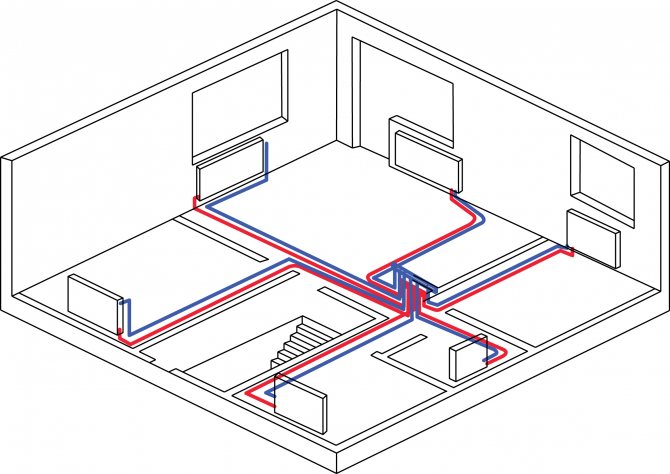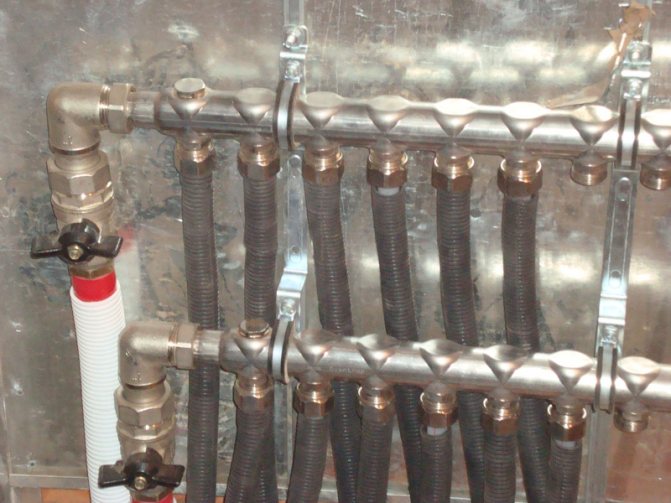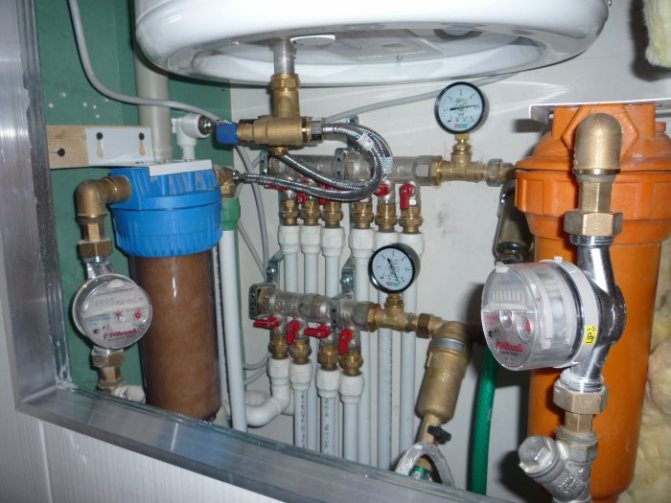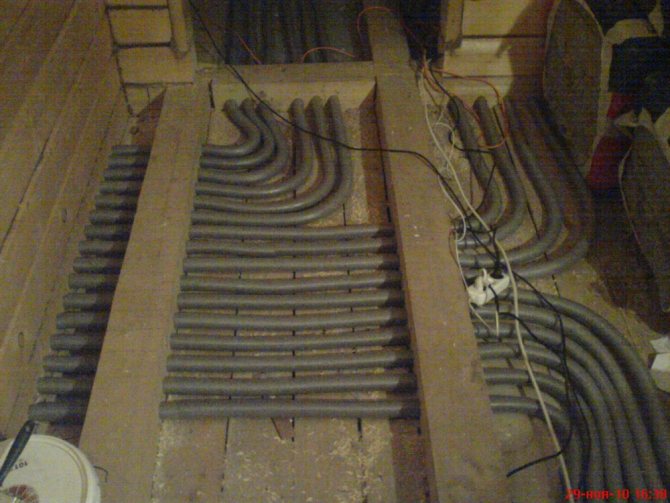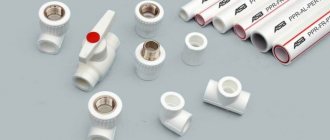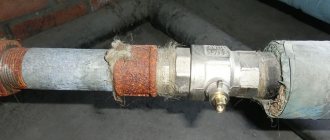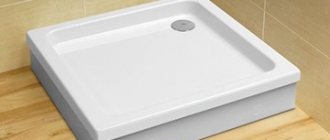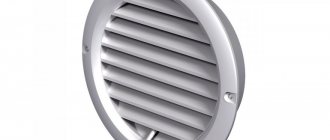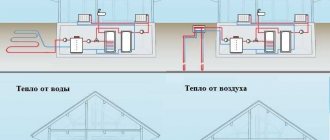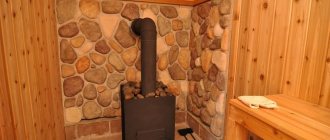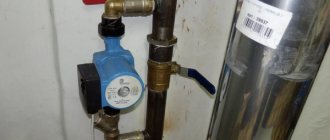Tee pipeline diagram
A tee circuit is a serial pipeline that runs from the riser to the last draw-off point. This type of plumbing is used in almost all apartments and private houses. This system has the following advantages:
- The tee circuit is quite economical, since a minimum amount of materials is required for a series connection.
- Ease of installation.
The T-piece system is recommended for use in smaller apartments. It also has its drawbacks. The main disadvantages of a series connection of pipes:
- Such a scheme provides for a large number of connection points, therefore, it is much more difficult to find the place of leakage in this case.
- Pressure drops may appear, which entails a decrease in pressure at the points of draw-off farthest from the riser. This usually happens when two or more taps are turned on at the same time.
- During the repair of the system, the entire water supply will have to be shut off. This is very inconvenient, especially if the work will last for several days.
- It is not always possible to install tees in a small space.
This system is often used in small apartments. When the number of water points is minimal, most of the shortcomings lose their relevance. It becomes quite simple to organize the coordination of water consumption, the likelihood of a decrease in pressure in a specific section of the distribution is minimized.
Often, with this scheme, communications are hidden behind walls or under the floor. In this case, it will not be possible to repair the leak in a short time, in addition, the finish will be damaged.
The use of a collector in a wiring
When using wiring using a manifold, many draw-off points can be connected, while distance from the riser does not affect the pressure in any way. The collector circuit implies the connection of each element (toilet bowl, sink, all mixers, shower room, etc.) through an individual outlet, on which shutoff valves are installed. The advantages of using a comb:
- The collector wiring of the water supply pipes in the apartment creates constant pressure in the entire system with any number of open water points.
- Ease of repair. Each individual line can be disconnected without shutting off the water supply throughout the apartment.
- The design is quite reliable, as it has a minimum number of joints.
- The water supply manifold can be hidden in a special niche or in a box. This option fits harmoniously into any design.
A plumbing comb has recently been often used for installing plumbing when wiring in a new building. Despite the large number of advantages, such a scheme has its drawbacks. Cons of collector wiring:
- For installation, a lot of pipes are needed, which directly affects the final cost.
- Such arrangement of the system is more complex than a tee circuit.
Collector piping in the apartment allows you to control the operation of each individual device that is included in the system. All kinds of filters or reducers can be installed on a separate water outlet.
Main characteristics of the collector system
The main difference between the collector and the standard linear method of redistribution of the heat carrier is the division of flows into several independent channels. Various modifications of collector units can be used, differing in configuration and size range.
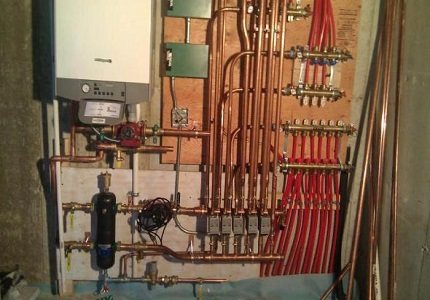
Often, the collector heating circuit is called radial.This is due to the design features of the comb. When inspecting the device from the top point, you will notice that the pipelines extending from it resemble the image of the sun's rays.
The design of the welded manifold is quite simple. The required number of nozzles is connected to the comb, which is a round or square pipe, which, in turn, are connected to the individual lines of the heating circuit. The collection unit itself is interfaced with the main pipeline.
Also, shut-off valves are installed, through which the volume and temperature of the heated liquid in each of the circuits is regulated.
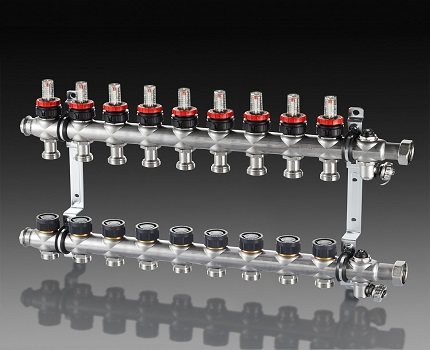

The collector group, complete with all the necessary parts, can be purchased ready-made or assembled independently, which will significantly reduce the cost estimate when designing heating
The positive aspects of operating a heating system based on a distribution manifold are as follows:
- Centralized hydraulic circuit distribution and temperature indicators occurs evenly. The simplest model of a two- or four-loop type ring comb can balance the performance quite effectively.
- Regulation of operating modes of the heating main... The process is reproduced due to the presence of special mechanisms - flow meters, mixing unit, shut-off and control valves and thermostats. However, their installation requires correct calculations.
- Serviceability... The need for preventive or repair measures does not require shutting down the entire heating network. Due to the sliding pipeline fittings mounted on each separate circuit, it is possible to easily shut off the flow of the coolant in the required area.
However, there are also disadvantages to such a system. First of all, the pipe consumption increases. Compensation of hydraulic losses is carried out by installing a circulation pump. It is required to be installed on all collector groups. In addition, this solution is relevant only in closed-type heating systems.
Installation of a distribution unit
Do-it-yourself wiring using a plumbing distribution unit. It is necessary that the central water inlet is connected directly to the collector. Pipes go from the distributor to each plumbing fixture. For a heating system, such devices are usually hidden in special cabinets.
Combs for supplying cold and hot water are most often located in a place located behind the toilet tank. Such systems are also called ray systems. For the supply of water supply or distribution of the coolant in heating systems, such schemes will differ in some features. You should pay special attention to these nuances.
The comb is connected to the water inlet through the ball valve. This is necessary so that there is always the possibility of a complete shutdown of the water supply. Together with the crane, it is advisable to install a coarse filter, which retains all coarse fractions that can harm the equipment.
After that, a water meter is installed, followed by another filter, but for cleaning smaller inclusions. Then a check valve is mounted. During the pressure drop in the central water supply, this element will not allow water to return to the general system.
The listed equipment is installed not only in the collector distribution, but also in the tee water supply circuit. The collection of elements is called a water metering unit.
After the water metering unit, the collector connection follows. Each branch should be equipped with a separate valve so that it is always possible to disconnect one branch of the water supply from the power supply.
Installation of a plumbing system
When a decision is made to choose a comb, it is necessary to take into account the presence of the required number of drainage points and water consumption. Their number must match. In order to be able to connect any additional devices in the future, it is necessary to provide for the presence of spare rods. The excess should be drowned out.
If the house is connected to centralized provision both cold and hot water, it is worth getting two collectors. When the apartment is connected only to cold water supply, one of the rods must lead to a heating device (gas water heater, boiler). Hot water from the water heater goes to the second comb. This is necessary to create a separate routing.
In the project, it is worth considering the distance from the distribution element to all points of the draw-off. The ideal installation location is one from which the distance to all plumbing fixtures will be approximately the same. This will save quite a lot of materials.
Plastic (polypropylene) pipes are considered the best for wiring in an apartment. This type of material has a long service life, is resistant to various external influences (including mechanical ones), and it is very easy to install wiring using pipes made of this material. Polypropylene is used not only for water supply, but also for laying sewers.
Heating with a comb
The collector circuit for laying heating is used quite widely. Using a comb, you can connect both radiators and the "warm floor" system. The implementation is as follows:
- The heat carrier is supplied from the boiler to the collector.
- The first comb is connected to the upper fittings of all batteries that are located in the house (if floor wiring is not provided).
- Then a second valve must be installed. The taps are connected to the return flow of the coolant.
- A booster pump must be installed in the return system. It is installed near the receiving connection located directly on the boiler.
- The expansion vessel must be installed at the highest point of the system. The type and volume of the tank is selected based on the volume of the coolant used.
If the heating is centralized, then the expansion tank, pump and individual boiler are not required. Otherwise, the system is mounted in the same way.
How species are
It should be noted that there are no cardinal variations of such equipment, but the main differences depend, first of all, on the material from which the collector was made, the number of circuits and additional built-in auxiliary devices.
The production of such combs, regardless of the complexity and multifunctionality of the equipment, can be established only when using materials very resistant to external factorsGiven this, the following types of collectors are distinguished:
- steel
- polymer
- copper
- brass
The number of contours varies from 2 to 12 pieces. In the case of an increase in heating equipment, it is easy to add missing circuits to the system. The level of complexity of the design can also be different, therefore, the following types of distribution combs are distinguished:
- The collector type will depend on the system
simplethat are not equipped with any auxiliary parts to regulate the operation of the device; - improved, with built-in control elements, automation, special sensors and a large number of fittings.
The simplest version of the heating distribution manifold is an iron pipe with a certain number of branches and two connecting holes on the sides. As for more complex models, they can be equipped with the following additional devices, namely:
- sensorsthat take into account the level of temperature and pressure;
- control units coolant supply;
- automatic thermostats, the main task of which is to maintain the system pressure within the normal range, and if the maximum permissible values are exceeded, automatically reduce it;
- electronic valves and mixersand, whose job is to maintain a pre-programmed temperature.
- automatic air outlets devices and valves for draining water.
Recommendations for choosing a product
Before choosing a comb, it is necessary to count all available water consumers (faucets, toilets, bidets, dishwashers and washing machines, etc.) and those that are supposed to be installed in the future. This is the main factor affecting the choice of manifold and the number of fittings. To simplify installation, a part with integrated valves can be purchased.
If there are not enough taps on the distributor for all water points, you need to buy several and connect them into one. To connect the collector to a plastic or polyethylene pipe, you need to buy a comb from the same material.
These devices are much cheaper than metal ones, but they are not inferior in reliability. In addition, polypropylene distributors are much easier to install. It must be remembered that such material is connected only with the help of a specially soldering iron.
The service life of steel, copper and polypropylene products reaches 50 years. Ball valves serve no more than 20 years. Therefore, it is worth purchasing distributors without built-in valves. It is better to buy them separately, so that later there will be an opportunity to replace them with new ones.
Most popular manufacturers
The choice of the manufacturer is one of the main points in the selection of the product. Nevertheless, few pay attention to the manufacturer, making a choice in favor of the cheapest goods. After a while, such a product fails and requires replacement.
Before purchasing all the materials, you should spend a little of your time finding a manufacturer you can trust. This will save you from constant repairs. Now the following firms are considered the most popular:
- Far. This is an Italian company that has already managed to gain a foothold in the Russian market. Its products are not very expensive, but they are of fairly high quality. A model with two taps costs about 1000 rubles. Each additional stock increases the price by about 300-400 rubles.
- Rehau. One of the most popular manufacturers on the market. The products of this company are bought because of the high trust in German quality. The cost of the distributors is relatively high, but the company remains quite in demand.
- Tiemme. It is an Italian company that produces high quality collectors.
- Luxor. Also an Italian manufacturer. Supervises each product at all stages of production. Produces high quality products.
- Solomon. For those who do not want to save on quality, but want to purchase an inexpensive device for water distribution. The brand is popular throughout the post-Soviet space.
Among domestic manufacturers, it is difficult to single out those that could compete with Italian or German quality. So that you do not have to constantly make repairs or replace the collector with a new one, it is better to immediately buy high quality products.
Products on the market
Depending on the material, the cost of products ranges from 400 to 2500 rubles. Collector groups for 200-300 outputs can cost 10,000-40,000 rubles.
There are models from different manufacturers on the market, popular ones include:
- Watts;
- Uponor;
- Giacomini;
- APC;
- Luxor;
- Fado;
- Caleffi;
- Valtec;
- Bianchi.
The stores offer not only combs, but also accessories. Products without taps are economical. They are used to set up individual wiring, make it possible to choose the right parts.Purchasing a product with shut-off valves will facilitate the installation process. When assembling units, there is no need to install valves.
Components are purchased to adapt the device to the home system. These include valves, valves, pumping groups. Mechanical actuators, plugs and fittings are required.
Manifold cabinets are used for wall mounting and maintaining an aesthetic appearance.

